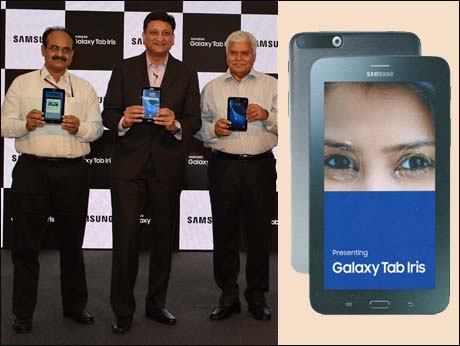
Huge potential of Aadhaar prompts Samsung to 'make in India' for its tablet-based iris authentication technology
By Anand Parthasarathy
May 30 2016: Last week, Samsung, staged a dramatic demo in Delhi. As the Telecom Regulatory Authority's Chairman, R.S. Sharma and the Unique Identification Authority of India's Director General A.B.P. Pandey, watched, a Samsung engineer used a just-launched tablet PC to scan the iris of Aloknath De, Samsung's India R&D head. Dr De supplied his Aadhaar number. Within a second, the tablet reported that it had successfully established that he was who he claimed to be -- and brought up his Aadhaar card on the screen.
The resounding taalis aside, this was a development whose potential is only now sinking in. Samsung's Bangalore-based engineers have designed and developed what is arguably the first -ever tablet PC-based system to authenticate a person's identity with near infallibility. To do this the team led by Dr De has incorporated a special camera to scan the iris of a person's eyes and uses a formula called 2-factor authentication to identify him or her to 99.9 percent certainty ( see box: Iris scanning: Infallible)
The Samsung Galaxy Tab Iris, replaces the front camera with an Iris scanner. In other respects this is a fairly standard 7 inch tablet with a quad core processor, a 5 megapixel autofocus rear camera, with a good 3600 mAh battery running Android Lollipop 5.11, with 1.5 GB RAM. What is unusual is the 8 GB storage, expandable to a massive 200 GB -- and one can see why. In authenticating identities, the tablet may have to store thousands of records. In addition to the software to run the iris identity check with a single click, the makers have made the tablet fully compliant with the Aadhaar data base and has been so certified by the quality control organisation, STQC. They have placed the tablet's identity software development kit in the public domain so that developers can create applications where the iris scan can be used at ration shops, or for disbursing payments under MNREGA, pension payments and any number of e-citizen services.
If one wondered why Samsung chose India to create this technology, Dr Pandey suggested the logic. With Aadhaar enrolments crossing 1 billion, every seventh human being now holds an Aadhaar identity. Samsung is known to have filed for two patents in iris scanning and has registered two trademarks: 'Samsung Iris' and 'Samsung Eyeprint'. Don't be surprised if the company, besides leveraging the first mover advantage for this huge Indian business, also looks at the global potential of its Made in India technology.
So who is the immediate customer for the Galaxy Tab Iris? Don't all rush, because it is not for you and m -- yet. Public service departments who may want to authenticate beneficiaries with minimum delay are the obvious users. But there are other scenarios: rapid insurance claim settlements; preventing ghost mobile phone subscribers, quick clearance at airport immigration, preventing impersonation in examination halls, rapid opening of bank accounts at the customer's home.....you name it. At Rs 13,499, the tablet is reasonably priced for such a path breaking technology.
Iris scanners on devices like phones and laptops are not new. Microsoft launched two Lumia phones -- 950 and 950 XL -- last October with inbuilt iris scanners which helped owners unlock their phones using its Windows 'Hello' feature. But such applications are trivial compared to what was showcased last week -- and when it trickles down from being an enterprise tool to a consumer accessory -- that'll be the revolution. Consider, you could , from the comfort of your home, self-scan your iris -- and initiate a payment or a document like a passport without physical appearance. This is the ultimate selfie on steroids!
'Look into my eyes... and when you find me there, you'll search no more', sang Bryan Adams in another era on the sound track of the film 'Robin Hood: Prince of Thieves'. Some lyrics can be so prescient -- in ways their writers never imagined.
Iris Scanning: Infallible
The iris scanner is built around a digital camera that uses visible and Infra Red light. By shining IR into the eye, it renders the pupil very black, making it easy to isolate the iris. It then locates the centre and edge of the pupil, the edge of the iris and the eyelid and eyelashes. Together these factors provide 200 points of reference against around 70 when you take a fingerprint. While fingerprints degrade especially when the subject does manual labour, eyes remain unchanged even after surgery. The blind too, have an iris. The chance of mistaking one person's iris for another's has been rated as one chance in 10 raised to the power 78 -- or virtually nil. Glasses or contact lenses won't affect the scan. (Source: How Stuff Works)